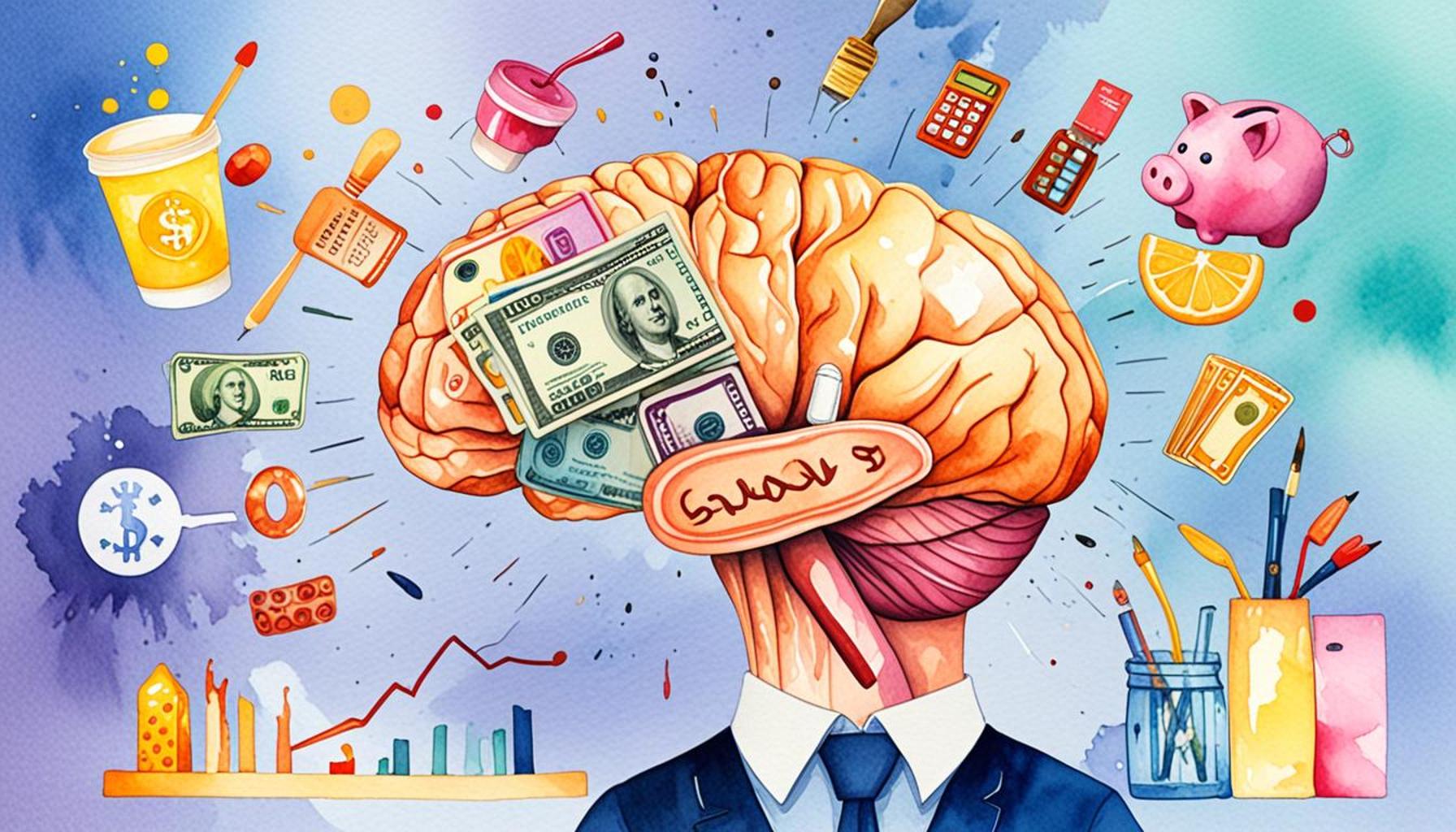How Financial Psychology Affects Our Consumption Decisions

Exploring Financial Psychology: The Human Element of Spending
In the contemporary landscape of consumerism, where choices abound, understanding the inner workings of human behavior in relation to financial decisions has become increasingly important. Financial psychology is an emerging field that investigates how our psychological makeup, including thoughts, emotions, and behaviors, shapes our spending habits and financial choices.
Emotional Responses in Financial Decisions
Emotions play a pivotal role in our financial decision-making process. For instance, when an individual experiences happiness, they may be more prone to treat themselves to luxury items or spontaneous purchases, such as dining out or shopping for new clothes. Conversely, feelings of stress or anxiety can lead to impulsive spending as a form of emotional relief or escape. A common example of this is the phenomenon known as “retail therapy,” where individuals indulge in shopping to alleviate negative feelings. Research has shown that emotional states can override logical assessments, prompting individuals to prioritize immediate gratification over long-term financial health.
The Impact of Social Influences
Social dynamics also play a critical role in shaping spending behaviors. Peer pressure and societal expectations can create a strong pull towards certain consumer patterns. For example, during the holidays, many feel compelled to spend more on gifts to keep up appearances or meet social standards. Furthermore, social media platforms amplify these pressures, showcasing lifestyles that may be financially unattainable for many. This constant exposure can lead to a cycle of comparison, where individuals may overspend to mimic the perceived success of others, ultimately impacting their financial stability.
Cognitive Biases and Financial Choices
Cognitive biases contribute significantly to irrational financial decision-making. Heuristics, or mental shortcuts, while often useful, can lead to errors in judgment that skew decisions. For instance, the present bias leads individuals to favor immediate benefits over more significant future gains. This is evident in the tendency to opt for the latest smartphone or a night out instead of saving for retirement. Research indicates that consumers frequently underestimate the importance of planning for the future, driven by the allure of present rewards.
Implications for Business and Consumer Practices
Understanding these psychological factors not only enriches our individual financial awareness but also offers valuable insights for businesses. Companies can devise marketing strategies that effectively target emotional triggers, creating campaigns that resonate on a deeper level. For example, by highlighting the joy of giving during holiday promotions, brands can connect with consumers’ emotions, thereby enhancing engagement and loyalty. By aligning marketing approaches with psychological insights, businesses can attract a more dedicated customer base while fostering responsible financial behaviors among consumers.
In summary, the intersection of psychology and finance presents essential insights for both consumers and marketers. Recognizing the profound influence of emotions, social dynamics, and cognitive biases on spending habits is crucial. By embracing this knowledge, individuals can cultivate healthier financial practices, while businesses can develop strategies that foster meaningful connections with their customers, ultimately leading to mutual benefits in a consumer-driven society.
DISCOVER MORE: Click here to learn about the advantages of investing in small-cap companies
The Interplay of Emotions and Financial Choices
Emotions serve as a significant driver in the realm of financial psychology, deeply influencing our consumption decisions. A range of emotions can dictate whether we feel compelled to spend, save, or invest our money. Understanding these emotional triggers is crucial as they can either encourage sound financial practices or lead to poor economic choices.
The Role of Positive Emotions
Positive emotions, such as excitement or joy, can often lead to increased spending. For example, a person celebrating a promotion may indulge in luxury purchases to reward themselves. This behavior is not without consequence, as the emotional high can prompt individuals to overspend in the short term. Engaging in such behaviors can result in a lack of foresight concerning long-term financial implications, particularly when individuals prioritize immediate gratification over future financial security.
Navigating Negative Emotions
Conversely, negative emotions can also play a pivotal role in our spending habits. Individuals experiencing stress may resort to what many call “emotional spending” as a coping mechanism; they buy items to boost their mood despite the potential financial repercussions. This form of spending can create a dangerous cycle of impulsivity, where the temporary relief from shopping leads to longer-term regret when bills come due.
Recognizing Emotional Triggers
In order to make more informed financial decisions, it is essential to recognize and manage emotional triggers. This can involve:
- Identifying specific emotions associated with spending.
- Maintaining a journal to track spending patterns when feeling certain emotions.
- Setting aside a “cooling-off” period before making major purchases, allowing time for reflection.
By acknowledging their emotional responses, individuals can cultivate a greater sense of self-awareness and take control of their financial decisions. This awareness can assist in developing healthier spending habits, ultimately leading to improved financial well-being.
Environmental Influences on Financial Decisions
Beyond personal emotions, external factors also play an influential role in consumption decisions. The environment in which we live can significantly affect spending behavior. For instance, living in a consumer-centric culture, such as that which prevails in many urban areas of the United States, can lead to higher levels of consumption due to constant exposure to marketing messages and products. This phenomenon is compounded by the societal belief that success is closely tied to material possessions.
As consumers, it is vital to remain mindful of the emotional and environmental influences guiding our spending habits. By cultivating an understanding of these dynamics, individuals can work toward making more rational financial decisions, prioritizing their long-term financial goals over fleeting emotions or societal pressures.
DISCOVER MORE: Click here to delve deeper
Cognitive Biases and Their Impact on Spending Behavior
In addition to emotional influences, cognitive biases significantly shape consumption decisions. Cognitive biases are systematic patterns of deviation from norm or rationality in judgment, and they can lead consumers to make financial decisions that may not align with their best interests. Understanding these biases can empower individuals to navigate financial choices more effectively.
The Anchoring Effect
The anchoring effect occurs when individuals rely too heavily on the first piece of information encountered when making decisions. For example, if a consumer sees a luxury watch priced at $5,000 and then encounters a similar watch on sale for $3,000, that person is likely to perceive the latter as an excellent deal, despite it being above their original budget or financial plan. This bias can lead consumers to make impulsive purchases driven by perceived value rather than actual need or affordability.
Present Bias and Immediate Gratification
Present bias refers to the tendency to prioritize immediate rewards over long-term benefits. This cognitive bias can lead individuals to overspend on current pleasures while neglecting savings or essential future investments. For instance, many Americans utilize credit cards to fund spontaneous purchases, feeling an immediate sense of satisfaction that often clouds the importance of paying off debt later. Statistically, the average U.S. household carries over $15,000 in credit card debt, a tangible representation of present bias in action.
Loss Aversion and Risky Decision-Making
The principle of loss aversion posits that individuals prefer to avoid losses rather than acquire equivalent gains. This can manifest in spending behaviors where people are reluctant to invest, fearing potential losses more than valuing potential gains. Research indicates that individuals often find a loss of $100 more distressing than the joy of gaining $100. As a result, such fears can lead to overly conservative financial decisions, where individuals forgo opportunities for growth and development in their investment portfolios.
Social Proof: The Influence of Others on Spending Choices
Social proof, or the tendency to mimic the actions of others in uncertain situations, deeply affects consumer behavior. In a social context where peers display wealth and consumption, individuals may feel inclined to follow suit, often purchasing items to fit in or gain social approval. A noteworthy example is found in online platforms, such as social media, where influencers showcase luxurious lifestyles. As consumers observe others engaging in high-consumption behaviors, they may develop a misguided perception of necessity surrounding these expenditures, leading to financial strain.
Strategies for Combating Cognitive Biases
To counteract the influence of cognitive biases on spending habits, individuals can adopt specific strategies. These strategies include:
- Implementing strict budgets that designate spending limits based on calculated needs rather than impulses.
- Conducting thorough research before making significant purchases to mitigate the anchoring effect.
- Enlisting accountability partners who can provide an outside perspective and remind individuals of their financial goals.
- Utilizing apps and tools that promote awareness of spending patterns, helping individuals recognize when cognitive biases may be taking hold.
By integrating awareness of cognitive biases into financial planning, individuals can enhance their financial trajectories and make informed consumption decisions that contribute positively to their overall fiscal health.
LEARN MORE: Click here to discover how to identify growth stocks with long-term potential
Conclusion
In summary, financial psychology plays a pivotal role in shaping our consumption decisions and overall financial well-being. As illustrated through various cognitive biases such as the anchoring effect, where individuals rely too heavily on the first piece of information encountered when making decisions, and present bias, which leads to prioritizing immediate rewards over future benefits, these psychological influences can lead individuals to make choices that may not serve their long-term interests. For instance, a consumer who sees a sale price of $80 for a jacket originally priced at $100 might anchor their valuation to the original price, perceiving the deal as more attractive than it may actually be.
Recognizing the inherent patterns in our decision-making allows us to adopt a more informed approach to spending and saving. To mitigate these biases, individuals are encouraged to implement practical strategies such as setting strict budgets, which can act as a safeguard against impulsive purchases, and engaging in thorough research before making significant purchases. For example, comparing prices online prior to buying a new electronics gadget can lead to finding a better deal, highlighting the importance of making informed choices.
Additionally, cultivating accountability relationships, such as discussing financial goals with a trusted friend or family member, can provide the necessary support to remain committed to financial plans. Moreover, embracing technology through financial apps can enhance awareness of spending patterns. These apps can provide real-time tracking of expenses and budget adherence, prompting better decision-making. By fostering a comprehensive understanding of the interplay between psychological factors and financial behavior, consumers can cultivate more judicious financial practices.
Ultimately, the pursuit of financial literacy and mindfulness in consumption decisions not only furthers personal financial health but also aids in building a more resilient economic framework within communities. In the context of the United States, where consumerism often drives economic growth, acknowledging the influence of psychological factors empowers us to make sound financial choices and encourages collective conscious spending. This paves the way for sustainability and growth in an increasingly complex economic landscape.









